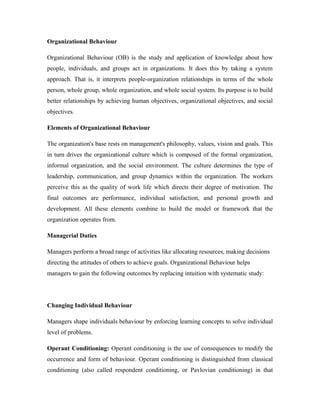
Ish 2 nd 1st question
- 1. Organizational Behaviour Organizational Behaviour (OB) is the study and application of knowledge about how people, individuals, and groups act in organizations. It does this by taking a system approach. That is, it interprets people-organization relationships in terms of the whole person, whole group, whole organization, and whole social system. Its purpose is to build better relationships by achieving human objectives, organizational objectives, and social objectives. Elements of Organizational Behaviour The organization's base rests on management's philosophy, values, vision and goals. This in turn drives the organizational culture which is composed of the formal organization, informal organization, and the social environment. The culture determines the type of leadership, communication, and group dynamics within the organization. The workers perceive this as the quality of work life which directs their degree of motivation. The final outcomes are performance, individual satisfaction, and personal growth and development. All these elements combine to build the model or framework that the organization operates from. Managerial Duties Managers perform a broad range of activities like allocating resources, making decisions directing the attitudes of others to achieve goals. Organizational Behaviour helps managers to gain the following outcomes by replacing intuition with systematic study: Changing Individual Behaviour Managers shape individuals behaviour by enforcing learning concepts to solve individual level of problems. Operant Conditioning: Operant conditioning is the use of consequences to modify the occurrence and form of behaviour. Operant conditioning is distinguished from classical conditioning (also called respondent conditioning, or Pavlovian conditioning) in that
- 2. operant conditioning deals with the modification of "voluntary behaviour" or operant behaviour. Operant behaviour "operates" on the environment and is maintained by its consequences. Reinforcement and punishment, the core tools of operant conditioning, are either positive (delivered following a response), or negative (withdrawn following a response). This creates a total of four basic consequences, with the addition of a fifth procedure known as extinction (i.e. no change in consequences following a response). Reinforcement is a consequence that causes behaviour to occur with greater frequency. Punishment is a consequence that causes behaviour to occur with less frequency. Extinction is the lack of any consequence following a response. When a response is inconsequential, producing neither favourable nor unfavourable consequences, it will occur with less frequency. Positive reinforcement occurs when behaviour (response) is followed by a favourable stimulus (commonly seen as pleasant) that increases the frequency of that behaviour. In the Skinner box experiment, a stimulus such as food or sugar solution can be delivered when the rat engages in target behaviour, such as pressing a lever. Negative reinforcement occurs when a behaviour (response) is followed by the removal of an aversive stimulus (commonly seen as unpleasant) thereby increasing that behaviour’s frequency. In the Skinner box experiment, negative reinforcement can be a loud noise continuously sounding inside the rat's cage until it engages in the target behaviour, such as pressing a lever, upon which the loud noise is removed. Positive punishment (also called "Punishment by contingent stimulation") occurs when behaviour (response) is followed by an aversive stimulus, such as introducing a shock or loud noise, resulting in a decrease in that behaviour. Negative punishment (also called "Punishment by contingent withdrawal") occurs when a behaviour (response) is followed by the removal of a favourable stimulus, such as taking
- 3. away a child's toy following an undesired behaviour, resulting in a decrease in that behaviour Using Motivation theories Organizational Behaviour helps managers providing motivation theories to motivate employees in order to: • Promote a healthy work force- satisfy employee’s physiological needs by providing incentives for mental and physical health • Provide financial security- an important safety need • go beyond traditional forms of compensation • address issue of job security, including out placement services • Promote opportunities to socialize- organize events that help to satisfy social needs • Recognize employee’s accomplishments- award programs satisfy esteem needs Managers that utilize these tools and ideas can be successful motivators. Conclusion Behaviour generally is predictable if we know how the person perceived the situation and what is important to him or her. An observer often sees behaviour as non rational because the observer does not perceive the environment in the same way. Certainly there are differences between individuals, placed in the same situation all people don’t act exactly alike. However there are certain fundamental consistencies underlying the behaviour of all individuals that can be identified and then modified to reflect individual development. Organizational Behaviour helps managers predict employee behaviour, shape them and
- 4. remove undesired behaviours. As management deals with people, Organizational Behaviour Studies helps to manage these people in a systematic way.